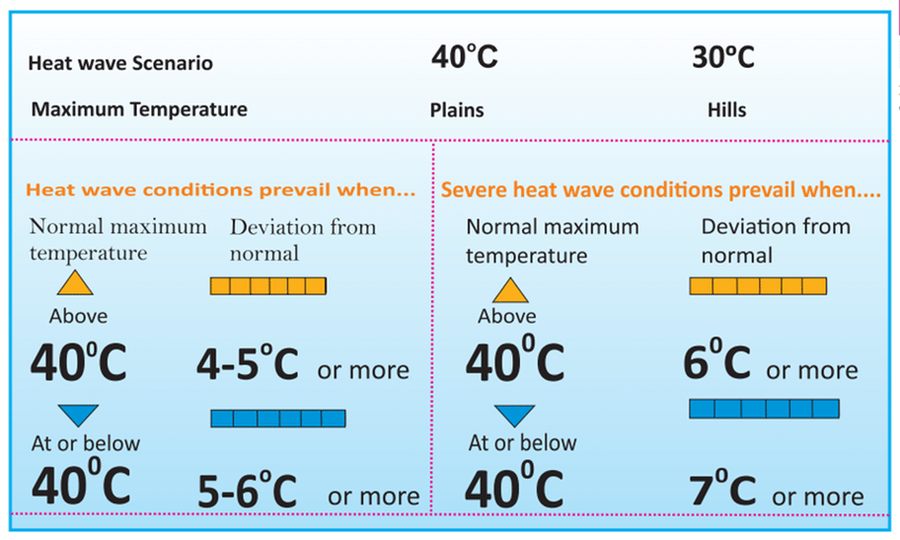Mains GS-II: International Relations & Institutions
GS-II
Q) What do you mean by heat waves? Discuss the reasons and impact of the rising frequency and intensity of heat waves across India. Also, suggest some measures to mitigate its effect.
Q) What do you mean by heat waves? Discuss the reasons and impact of the rising frequency and intensity of heat waves across India. Also, suggest some measures to mitigate its effect.
Approach
Introduction: Explain what is heat waves
Body: Explain the reason and its impacts and then give some mitigation measures.
Conclusion: Conclude holistically.
Answer
A Heat Wave is defined as a period of abnormally high temperatures over a region. The heat wave is considered when the maximum temperature of the region reaches at least 40 degrees Celsius for plains and at least 30 degrees Celsius for hilly regions.
Parameters for defining Heat Waves:
Reasons for the rising frequency and intensity of heat waves across India:
- Global warming and climate change lead to increased overall temperatures. India has been experiencing a warming trend over the past few decades. Example: according to the India Meteorological Department (IMD), the average temperature in India has increased by approximately 0.6°C over the last century.
- Local weather conditions, such as clear skies, low humidity, and lack of wind, contribute to temperature build-up. Example: During a heatwave, clear skies allow for maximum solar radiation to reach the Earth's surface, leading to increased heating.
- Urbanization and concrete structures in cities lead to the urban heat island effect. The extensive use of concrete and asphalt in cities absorbs and retains heat, contributing to elevated temperatures. Example: Urban heat island in Delhi.
- Deforestation and land-use changes affect local climate patterns and reduce natural cooling mechanisms Example: Deforestation reduces the number of trees and vegetation that provide shade and evaporative cooling, resulting in increased surface temperatures.
- Influence of regional weather patterns, such as the delay or absence of monsoon rains, leading to prolonged dry spells and heatwave conditions Example: Delayed or weak monsoons can lead to prolonged dry spells, reduced moisture availability, and heatwave conditions in India.
- Geographic factors, such as the presence of heat-trapping geographical features like mountains or deserts, amplify temperatures in specific regions. Example: Geographical features like mountains can create rain shadow regions where moisture is blocked, resulting in arid conditions and higher temperatures.
Impacts of heat waves across India:
- Increased mortality and heat-related illnesses: Heat waves can lead to a rise in heatstroke, dehydration, and other heat-related illnesses, resulting in increased mortality rates, particularly among vulnerable populations such as the elderly and outdoor workers. For example, a study by the Indian Meteorological Department found that heat waves caused an estimated 2,500 deaths in India in 2015
- Agricultural losses: Heat waves can cause significant damage to crops, leading to reduced agricultural productivity and economic losses for farmers. Heat stress can affect crop growth, reduce yields, and even lead to complete crop failures. For example, a study by the Indian Council of Agricultural Research found that heat waves caused an estimated $2 billion in crop losses in India in 2015.
- Water scarcity: Heat waves intensify water evaporation, leading to increased water demand for irrigation and domestic use. This can exacerbate existing water scarcity issues, especially in regions already facing water stress.
- Infrastructure damage: Extreme heat can cause the expansion of materials, leading to damage to roads, bridges, and buildings. Railway tracks can also buckle under the intense heat, causing disruptions in transportation systems. For example, a heat wave in 2015 caused widespread power outages in India, affecting millions of people.
- Ecosystem disruptions: Heat waves can disrupt ecosystems by causing habitat loss, altering plant and animal behaviour, and increasing the risk of wildfires. These disturbances can have long-term implications for biodiversity and ecological balance.
- Social and economic disruptions: Heat waves can lead to social disruptions, such as migration from rural to urban areas in search of relief from extreme heat. This migration can strain urban resources and services. Moreover, economic losses from heat-related damages and decreased productivity can impact various sectors of the economy.
Mitigation measure:
- Heatwave early warning systems: Implementing robust early warning systems that provide timely and accurate information about impending heatwaves can help communities and authorities take preventive measures.
- Heatwave action plans: Developing and implementing heatwave action plans at the national, state, and local levels to guide preparedness, response, and mitigation strategies during heatwave events.
- Urban greening and cool roof initiatives: Promoting the use of green spaces, trees, and vegetation in urban areas can help mitigate the urban heat island effect. Additionally, encouraging the use of cool roofs that reflect sunlight and absorb less heat can reduce building temperatures.
- Sustainable urban planning: Incorporating sustainable urban planning practices such as efficient building design, proper ventilation, and urban heat island mitigation strategies can help create heat-resilient cities.
- Heat-sensitive infrastructure design: Incorporating heat-sensitive infrastructure design principles in critical infrastructure projects can help minimise the impact of heat waves. This includes designing buildings, transportation systems, and energy infrastructure that are resilient to extreme heat.
- Strengthening healthcare systems: Enhancing the capacity of healthcare systems to respond to heat-related illnesses, ensuring the availability of medical resources, and training healthcare professionals to identify and treat heat-related conditions.
- Climate change mitigation and adaptation: Take measures to reduce greenhouse gas emissions, promote renewable energy sources, and adapt to the impacts of climate change comprehensively and sustainably to mitigate the frequency and intensity of heat waves in the long term. Examples of initiatives like the National Solar Mission (NSM), NAPCC, and International Solar Alliance.
Addressing heat waves in India requires urgent action through early warning systems, public awareness, heat-resilient infrastructure, sustainable agriculture, and renewable energy. Proactive measures are crucial to protect vulnerable populations, enhance resilience, and mitigate the risks posed by increasingly severe heat waves.

